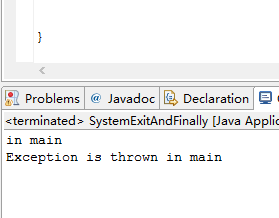【作业】请阅读并运行AboutException.java示例,然后通过后面的几页PPT了解Java中实现异常处理的基础知识。
程序源代码:
import javax.swing.*;
class AboutException {
public static void main(String[] a)
{
int i=1, j=0, k;
k=i/j;
try//这段代码可能会出现错误
{
k = i/j; // Causes division-by-zero exception
//throw new Exception("Hello.Exception!");
}
catch ( ArithmeticException e)
{
System.out.println("被0除. "+ e.getMessage());
}
catch (Exception e)
{
if (e instanceof ArithmeticException)
System.out.println("被0除");
else
{
System.out.println(e.getMessage());
}
}
finally
{
JOptionPane.showConfirmDialog(null,"OK");
}
}
}
运行结果截图:

【作业】请尝试解释以下奇怪的现象!

解释:

【作业】阅读以下代码(CatchWho.java),写出程序运行结果:
public class CatchWho {
public static void main(String[] args) {
try {
try {
throw new ArrayIndexOutOfBoundsException();
}
catch(ArrayIndexOutOfBoundsException e) {
System.out.println( "ArrayIndexOutOfBoundsException" + "/内层try-catch");
}
throw new ArithmeticException();
}
catch(ArithmeticException e) {
System.out.println("发生ArithmeticException");
}
catch(ArrayIndexOutOfBoundsException e) {
System.out.println( "ArrayIndexOutOfBoundsException" + "/外层try-catch");
}
}
}
运行结果截图:

分析:
注意其结构,里面的try抛出异常一,对应的catch(紧跟着的catch)接收一并执行,外层的try抛出异常二,对应的catch接收二并执行,抛出异常和接收异常这执行可以看成是一个单一的动作操作,最后的catch就没有抛出这一动作执行,所以不运行(因为抛出异常一已被接住)。
【作业】写出CatchWho2.java程序运行的结果
public class CatchWho2 {
public static void main(String[] args) {
try {
try {
throw new ArrayIndexOutOfBoundsException();
}
catch(ArithmeticException e) {
System.out.println( "ArrayIndexOutOfBoundsException" + "/内层try-catch");
}
throw new ArithmeticException();
}
catch(ArithmeticException e) {
System.out.println("发生ArithmeticException");
}
catch(ArrayIndexOutOfBoundsException e) {
System.out.println( "ArrayIndexOutOfBoundsException" + "/外层try-catch");
}
}
}
运行结果截图:

分析:
此例题和上面例题的区别就在于,里面的catch所接住的方向变了。
按着程序顺序分析下来,当里面的try抛出异常时,只有外面的catch能接住,那么开始执行外面的catch,顺序就从刚才执行的语句之下执行下去了,即便是外面的catch交换顺序,结果一样不变。
由两题总结:try catch这一模式,是有顺序依据的,当执行try语句是,紧接着的就是所对应的catch来执行,然后接着catch继续执行下去。
【作业】请先阅读 EmbedFinally.java示例,再运行它,观察其输出并进行总结。
public class EmbededFinally {
public static void main(String args[]) {
int result;
try {
System.out.println("in Level 1");
try {
System.out.println("in Level 2");
// result=100/0; //Level 2
try {
System.out.println("in Level 3");
result=100/0; //Level 3
}
catch (Exception e) {
System.out.println("Level 3:" + e.getClass().toString());
}
finally {
System.out.println("In Level 3 finally");
}
// result=100/0; //Level 2
}
catch (Exception e) {
System.out.println("Level 2:" + e.getClass().toString());
}
finally {
System.out.println("In Level 2 finally");
}
// result = 100 / 0; //level 1
}
catch (Exception e) {
System.out.println("Level 1:" + e.getClass().toString());
}
finally {
System.out.println("In Level 1 finally");
}
}
}
运行结果截图:

finally是无论是否出现异常都会执行的,在第三个try中出现异常,紧跟着的catch已经接收到,但此并不算第二个try出现异常,因为异常已经解决,那么之后就不会显示第二个和第一个catch的内容了
【作业】辨析:finally语句块一定会执行吗?
请通过 SystemExitAndFinally.java示例程序回答上述问题
public class SystemExitAndFinally {
public static void main(String[] args)
{
try{
System.out.println("in main");
throw new Exception("Exception is thrown in main");
//System.exit(0);
}
catch(Exception e)
{
System.out.println(e.getMessage());
System.exit(0);
}
finally
{
System.out.println("in finally");
}
}
}
运行结果截图:

总结:
JVM是java虚拟机,finally是由JVM保证执行,而System.exit(0)是正常退出程序,结束JVM的运行,那么最后finally就不再执行。
finally语句不被执行的唯一情况是先执行了用于终止程序的System.exit()方法
【作业】编写一个程序,此程序在运行时要求用户输入一个 整数,代表某门课的考试成绩,程序接着给出“不及格”、“及格”、“中”、“良”、“优”的结论。
要求程序必须具备足够的健壮性,不管用户输入什 么样的内容,都不会崩溃。
import java.util.Scanner;
public class Mark{
public static void main(String[] args){
Scanner sc =new Scanner(System.in);
int score=0;
System.out.print("请输入成绩:");
try{
score=sc.nextInt();
if(score>=0&&score<=59)
{
System.out.println("不及格");
}
if(score>=60&&score<=69)
{
System.out.println("及格");
}
if(score>=70&&score<=79)
{
System.out.println("中");
}
if(score>=80&&score<=89)
{
System.out.println("良");
}
if(score>=90&&score<=100)
{
System.out.println("优");
}
if(score<0||score>100)
{
System.out.println("输入的数字过大或过小");
}
else
{
System.out.println("");
}
}
catch(Exception e)
{
System.out.println("请输入正确数字:");
}
}
}
运行结果截图:

